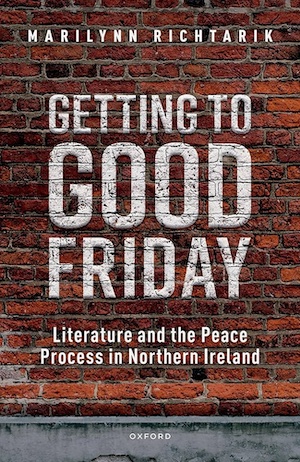By Fred H. Lawson
Undertaking interdisciplinary studies of conflict resolution seems like a very good idea. Contributions by political scientists and sociologists often claim that changes in the various actors’ conceptions of the stakes involved in a dispute, as well as their perceptions of one another’s motivations, play a crucial role in determining why the conflict suddenly becomes amenable to settlement. Consequently, it makes good sense to explore the impact that the literature of the day has in prompting, nurturing or articulating crucial changes in attitudes among combatants. Anyone annoyed by the rationalistic concepts that pervade most social scientific research on conflict resolution will welcome a more culture-oriented way of approaching the topic.
Getting to Good Friday takes a particularly complex and intractable dispute, the struggle between Unionists and Nationalists for control of the northeastern quarter of the Emerald Isle (the author points out how tricky it is even to name the elements of this dispute in an objective or unprejudicial way), and proposes that the negotiations that led to the remarkable April 1998 agreement that brought the Troubles to a close can best be understood by linking them to the novels, plays, poems, and other forms of literary output that accompanied the bargaining. Such writings as Seamus Heaney’s The Cure at Troy, Deirdre Madden’s One by One in the Darkness, and Bernard MacLaverty’s Grace Notes are put forward as works of fiction that had a bearing on real-world politics.
How this actually happened is not especially clear. Marilynn Richtarik offers a lengthy summary, appreciation, and dissection of The Cure at Troy, suitable for publication as an essay of literary criticism. She then abruptly turns to a recounting of the interplay among Sinn Fein, the Social Democratic and Labor Party, and the British government over the course of the late 1980s and early 1990s. All that joins the two excurses together is the transitional word “Meanwhile”. Did any of the negotiators see the play? Did they read published accounts or reviews of it? Did newspaper editors disseminate pithy phrases that it coined? Did audiences march out of performances and demand new ways of dealing with one another? Even readers who are favorably disposed to Richtarik’s research project will be left wondering why they labored through a detailed discussion of the play.
One by One in the Darkness is covered without any attempt to connect it to the peace talks. The novel simply “illustrates the traumatic effect the Troubles had even on people as yet physically unscathed by political and sectarian violence.” Grace Notes, by contrast, is shown not so much to have shaped events as to have been shaped by them; MacLaverty transformed both the novel’s basic structure and its main characters in direct response to developments in the conflict between the Unionists and the Nationalists. In the midst of the discussion of Grace Notes, Richtarik interjects: “Those working in conflict resolution have noted the role of narrative in changing destructive habits of mind and patterns of interaction.” But instead of applying this insight to show how the novel advanced the Good Friday talks, she holds forth on how the protagonists in the novel exemplify the dynamics that peace researchers have discovered.
Finally, Richtarik examines the “first-person reminiscences” of high-ranking participants in the peace process using literary textual analysis. To a non-specialist, the treatment looks a lot like a simple retelling of the speeches and statements made by prominent individuals. What the academic discipline of literary criticism has added to the story is hard to discern. Instead of composing a conclusion to the chapter that spells out the insights one gains from the exercise, yet another novel is introduced—Colum McCann’s TransAtlantic.
So it remains an open question whether or not a sophisticated survey of the literary output that surrounds a deep-seated social dispute can further our understanding of how that dispute comes to an end. Interdisciplinary inquiry turns out to be difficult. Getting to Good Friday expertly analyzes important works of fiction that appeared in northern Ireland at the time of the peace process, but does little to connect these writings to that process or its eventual outcome.
Fred H. Lawson (ΦBK, Indiana University) is Professor of Government Emeritus of Mills College at Northeastern University.




